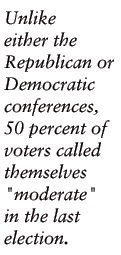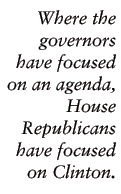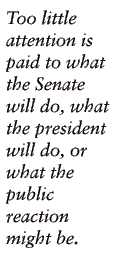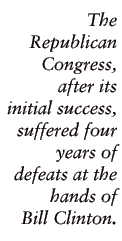- Campaigns & Elections
- Politics, Institutions, and Public Opinion
- State & Local
- Congress
One afternoon in fall 1999, as members of the House Appropriations Committee argued over a Republican leadership proposal to spread Earned Income Tax Credit (EITC) payments to the working poor over 12 months instead of disbursing them in lump sums, Republicans got the shock of the political budget season. The unthinkable happened. The handpicked candidate of two-thirds of House Republicans, George W. Bush, turned on them without warning.
Bush memorably told reporters that he opposed the leadership’s plan to delay EITC payments because, he said, "we shouldn’t balance the budget on the backs of the poor." This provoked an angry response from House Republicans. Majority Whip Tom DeLay publicly rebuked Bush, saying the Texas governor didn’t understand how Congress worked.
No, more likely, Bush understood exactly what he was doing. He was distancing himself from an unpopular Republican Congress. Bush had been looking for the right moment to draw a clear distinction; for House GOP leaders, as they struggled to find a way out of the budget box in which they found themselves, he couldn’t have picked a worse time.
The family feud gave pundits plenty of fodder for the week and did indeed help Bush establish several degrees of separation between himself and fellow Republicans in Washington. It also brought out into the open a little secret that has been the subject of GOP whispering for months: There are two Republican Parties in America today — two emerging party "brands." One is the "Republican governor" brand. The other is the "Republican Congress" brand. And the public has demonstrated a clear preference for the former over the latter.
The world of brands
Political branding isn’t very different, really, from branding in the business world. In one of the authoritative works on the subject, TechnoBrands, marketing guru Chuck Pettis describes what makes a brand:
"The sensory, motive, and cultural proprietary image surrounding . . . a product."
"A promise of performance."
"An enhancement of perceived value and satisfaction through associations that remind and entice customers to use the product."
"A significant source of competitive advantage."
Just so. Voters select their product — a party or candidate — based on similar motivations: perceived benefits, image, and ability to perform, as well as shared value systems. The degree to which parties and candidates are successful in creating a "popular" brand dictates their competitive position come election time.
In the past, Republican and Democratic brands have vied for dominance. Occasionally, a third party rose up and joined the fray. Today, however, we see competing brands not just across the political spectrum but also within the parties. In the past few years, some Democrats, under the leadership of President Clinton, have attempted to rebrand themselves as a Third Way, center-left party of "New Democrats" — to distinguish themselves from the old brand of a liberal Democratic Party. The Republicans, too, have competing brands.
Interestingly, the "governor" brand and the "Congress" brand of the GOP share similar conservative positions on most issues. But their philosophical attitude toward the role and value of government and their approach to representation are significantly different. The outcome of the 2000 election will likely rest on which of these two brands is dominant in voters’ minds on election day. The Republican Party strategy will be to make congressional Republicans look more like their more popular "governor" brand — while Democrats will try to tie the Republican presidential nominee as closely to House Republicans as possible.
What has caused this difference and disconnect between the Republican Congress and the Republican governors — at least in the public’s mind?
Different electorate, different approach
Governors are responsible for a broad cross-section of Americans — everyone in their states. As a result, they must accommodate the views and needs of a wide variety of people. They need a broad mandate to govern effectively. Successful 
House members, by contrast, tend to represent extremely homogeneous districts. Regardless of party, when most House members go home to their districts, they suffer from what we might call an "echo effect." More often than not, they hear a narrow party base message from their constituents; and, as a result, they have difficulty gaining perspective on the larger electorate. The overwhelming majority of these Republicans come from districts where the real election occurs in the primary. The threat for most Republican members (and this is equally true for Democrats) is not from Democrats, but from a primary challenger, usually from the ideological right (or in the case of Democrats, the ideological left).
A good example is Mark Souder of Indiana. Although he is one of the leading conservatives in Congress and a key member of the Conservative Action Team (cats), Souder has a primary opponent this year who is running because he believes Souder isn’t sufficiently conservative. Primary challenges are difficult and expensive even when they are not fatal to a political career. They are to be avoided. And politicians in districts such as these often tilt toward the most conservative policies and politics in order to fend off such primary challenges. At the national level, this phenomenon divides the party into a dogmatic brand and a pragmatic brand.
Safe districts produce longevity in office, and that is typically a requirement for a position in the House leadership. So it is that leaders are especially vulnerable to the "echo effect." Even if Republicans lose 100 seats in the next election, most leadership seats are so safe that few of these members, if any, would be among the missing come January 2001. Yet control of the House lies in the outcome of 60 to 90 districts that are far more ideologically diverse. What the members of leadership hear from their own districts tends to skew them away from politics and policies that will help them win those seats and hold the majority.
Add to this problem the fact that these members are trying to lead a conference in which 80 percent of the members are from districts similar to their own. They find themselves faced with the Solomon-like task of trying to balance the wishes of the overwhelming majority of their conference members with the differing needs of perhaps 20 percent of the members on whose electoral fate the majority rests.
The "echo effect" could be significantly diminished by using information, typically in the form of survey research, to help understand the concerns of the broader electorate and how Republicans could craft policies to address those concerns and retain their majority in the process. In the 105th Congress under Speaker Newt Gingrich, however, staff regularly refused to allow the presentation of that kind of information in 
In the months and weeks leading up to the 1998 election, many key Republicans and their political advisors predicted winning 30 seats or more — despite the fact that outside polls, and even some internal ones, showed that trouble was looming. The end result was a historic loss for Republicans in the 1998 election, one that showed how out of touch Gingrich and other Republican leaders were with American opinion.
The redrawing of congressional district lines following the 1990 Census also added to the problem of the "echo effect" — by creating more majority-black districts and whiter majority-white districts. The number of African Americans elected to Congress increased 50 percent from the 1990 election to the 1992 election (26 to 39). Congressional representation quickly reflected the more homogenous districts. Majority-black districts elected very liberal members; other districts elected more conservative members. In the two elections that followed the 1990 redistricting, Republicans picked up 10 seats and then 52.
Thus began the battle for the House that continues today, with both the majority and minority party caucuses composed of a majority of members whose political views and approach to politics are far more dogmatic than the electorate at large. For Democrats, this translated into a decision to push President Clinton to pursue a very liberal agenda in 1993-94. He did, and Democrats were thoroughly beaten in the 1994 election.
The new Republican majority, however, misread that election as a mandate for conservative reform no less dogmatic in substance and style. The great budget fight of 1995 was the result and led to the defeat of the Republican presidential nominee; the loss of House seats in 1996; and a historic loss of House seats in 1998.
Unlike either the Republican or Democratic conferences, 50 percent of voting Americans called themselves "moderate" in the last election. But while many Americans may label themselves moderate, survey research suggests that a better description of them might be as non-ideological, results-oriented solution-seekers — a new outcome-based segment of the electorate. The election in 2000 will be decided by the expanding group of voters looking for results-based proposals from candidates, not by political rhetoric about taking the country "right" or "left."
Support from these solution-seekers in the electorate is a major reason Republican governors have been so successful — whether they be moderate Republicans like 
Not all Republican governors have been equally successful in producing "solutions"; but as a general rule, they have tended to govern in a more pragmatic and less dogmatic way than congressional Republicans. Christie Todd Whitman delivered a huge tax cut. John Engler led the way on welfare reform. Jeb Bush adopted a new results-oriented approach to affirmative action that focused on providing real opportunity. Gov. Tommy Thompson of Wisconsin broke the back of the NEA education monopoly with a school voucher program that put children ahead of the education bureaucracy.
Why have governors been more successful in proposing and implementing their solutions-based legislative programs? There are several reasons.
The Clinton effect
Where the governors have focused on an agenda, House Republicans have focused on Clinton. To be sure, governors have had a strategic advantage over congressional Republicans. While working to build majority support, they haven’t had to personally engage Clinton on the legislative battlefield, nor have they been on the receiving end of his notoriously effective political rhetoric. That alone has helped them create a positive image that has translated into their popular brand.
That said, congressional Republicans must shoulder some of the blame for failing to develop a successful strategy for dealing with Clinton. Instead of taking on Clinton’s bad ideas, as they did with health care, they let Clinton become their focal point. Instead of proposing and marketing a Republican agenda that responded to the concerns of the American people, their mantra became: "If Clinton’s for it, we’re against it."
This created serious problems as Clinton moved to the center, embracing Republican principles. Rather than declare Clinton’s policy retreat a victory for conservative and Republican principle — which, in fact, it was — Republicans sought to show America how they differed with Clinton. They refused to accept that 60 percent of Americans approved of the job he was doing. So they found themselves sometimes arguing against their own policies and victories as they swam against the tide of Clinton’s job approval numbers.
The American people transferred their unhappiness with the Republican criticism of Clinton, which they perceived as personal attacks, to the House Republican brand. 
Clinton shamelessly embraced the issue as his own, taking the lion’s share of the credit. The Republican governors, who had been clamoring for reform, put their own personal stamp on the issue as they aggressively implemented their own state programs. Meanwhile, as House Republicans tried to claim their share of the kudos, the American public has only begrudgingly and minimally acknowledged their role. Clinton and the Republican governors, not the congressional Republicans, were the big political winners in welfare reform.
Welfare reform isn’t the only instance in which House Republicans lost a battle for message that they should have won. A simple policy example is also an interesting trivia question. Who first suggested the idea of funding 100,000 new teachers — a proposal resoundingly opposed by most House Republicans last year? The answer is former House Republican congressional leader Bill Paxon of New York — although his proposal gave local schools more flexibility to implement the program.
Education should be a winning issue for Republicans. Clearly, the liberal Democratic programs of the past 30 years have not improved the education of our children, nor have the billions of federal dollars poured into them achieved real results. Yet, when House Republicans fought the 100,000 teachers proposal, the American public viewed their opposition as a knee-jerk anti-Clinton reaction rather than a substantive policy difference. They were right and wrong. The opposition to the Clinton teacher proposal was rooted in a desire to move away from the practice of Washington dictating education policy to allow for greater local decision-making. But many Republicans opposed the legislation out of hand because of its source.
It’s true that research shows that Americans have been developing a negative attitude toward Clinton at a personal level, but they also view the Republicans’ opposition to seemingly all of "Clinton’s" ideas in an equally negative way. As a result, when the Lewinsky scandal erupted, the public simply extended its hardening perceptions of Republican motives by choosing to believe that impeachment wasn’t about breaking the law or lying before a grand jury. It was simply the conclusion of a long vendetta.
Meanwhile, as Americans came to see Washington as the "forces of Clinton" and the "forces of anti-Clinton" playing out the final moves in a high stakes political game that had little to do with them, Republican governors steered clear of the mess in Washington. Instead, they focused on producing results in the states, laying out a Republican agenda, and creating a governing majority. George Pataki in New York, a state with significantly more Democrats than Republicans, has tremendous support based on his successful efforts to decrease taxes, reduce crime rates, make government more efficient, and improve schools. Looking at the brand popularity of Pataki, the Bush brothers, Thompson, Frank Keating of Oklahoma, and others, the strategy of focusing on results has worked.
The medium is the message
Governors also communicate differently than House Republicans. They are physically closer to the people they govern. When it comes to winning support for their policies, they have a natural geographic advantage over their Republican colleagues in Washington, legislating far from home. Additionally, their daily schedules are generally structured to highlight their message. Whether it is visiting a school to focus on education needs or a hi-tech business to discuss new jobs, as state chief executives, they command media attention and have enormous power and staff resources to define and drive their administrations’ messages. As the nation’s chief executive, the same has been true for Clinton. He drives the message for his administration, and his cabinet and staff sustain that message.
In the House, there is no such message discipline. Rather than driving a single agenda, the message coming from the House is a combination of multiple agendas forced together to satisfy many members. The House leadership exacts no penalty, for example, if the chairman of a particular committee decides to talk about an issue that might contradict or step on the "theme of the day" or week. There are literally scores of press conferences every week on the Hill, and leadership is generally at the mercy of members’ personal agendas and the committee chairs’ good will.
Rather than driving a message or policy, congressional Republicans tend to cloister together in meetings devoted to handling the conflicting policy needs of members. As a result, the emphasis is not on communicating ideas to the American people but on how, mechanically, to get policy done. This has put the communications staff at a significant disadvantage vis-à-vis the policy staff — rather like letting 
Both policy and communications staff are crucial to passing good legislation, but because congressional policy staff has been far more powerful, particularly during the Gingrich years, communications — message development — has been reduced to a footnote during the tactical planning. I use the phrase "tactical planning" because policy development itself is often purely tactical, with the focus on how to get 218 votes to pass legislation.
Too little attention is paid to what the Senate will do, what the president will do, or what the public reaction might be. This knowledge vacuum has led to a major disconnect with current events and basic opinion trends among Americans — which, in turn, has led to two successive election defeats.
What too many policy people forget is that even good policy passed on the wrong day or without a communications component gets lost in the information overload most people experience on a daily basis. They have forgotten that the battle isn’t for 218 votes or the strength to break a filibuster. It’s for the hearts and minds of the American people. That’s a battle that is ultimately won in the living rooms of America — not on the House or Senate floor.
A painful example of this occurred in the fall of 1997. The House Republican Conference staff, which has primary responsibility for communications strategy, was asked to put together an "Education Week" focusing on Republican education initiatives. The staff developed an excellent plan, which included active involvement of conservative family groups. On the Monday of "Education Week," the policy and floor staff informed the conference staff that a change in schedule had occurred, and a key abortion vote would take place midweek. Naturally, the conference staff was stunned. Not only would the abortion vote overshadow their education effort, but the family groups they were relying on would likely back out of the education effort to focus on the abortion vote.
The conference staff was told that given the time constraints of the session, the scheduling of the abortion vote was unavoidable to finish everything the leadership wanted. Even though Republicans ostensibly controlled the schedule, those in control of the schedule could not avoid stepping on their own agreed-upon education communications effort. This in turn angered the family groups, for giving them such little notice on a key abortion vote, and it surprised the regular Republican membership with a last-minute critical vote on a touchy subject.
Governors, on the other hand, have used the process to their advantage. Whether it be a legislative session, federal funding, or a key legal case, governors have been far more successful in using various avenues to drive their agenda and message. Republicans in the House have suffered under an inflexible process that has prevented them from using the floor, the legislative agenda, and their own bully pulpits to their advantage. Democrats, with far more experience in governing the House, have manipulated the 
Historically, policy staffers have always wielded tremendous power. But too much legislation has been crafted with insufficient attention to its political ramifications. House Republicans are paying the price for these apolitical policy initiatives with a negative party brand.
The Patients’ Bill of Rights legislation in the House is a good example. In October, when 70 Republicans jumped ship and voted for the Dingell-Norwood bill, they handed their leadership an embarrassing setback. The Republican position failed to reflect the depth of voter sentiment on this issue, and until the final days of the debate, there was no timely and viable Republican alternative. The defecting Republicans, however — who withstood fierce pressure to stick with their leadership — understood the political importance of the issue all too well. That is because most were from tough districts and face difficult reelection bids. They read and believe polls. And like the governors, they face a more diverse electorate. They concluded that they could not vote with the leadership and survive next year’s election.
Many policy people disdain communications planning and reject public opinion polling, wrongly assuming that the validity of ideas is enough to win on the political battlefield. If that were the case, conservative policy initiatives should have put congressional Republicans in a winning position. Instead, the Republican Congress, after its initial success, suffered four years of humiliating defeats at the hands of Bill Clinton, who has successfully coopted conservative ideas and the credit that goes with them.
Lest anyone get a misimpression, there is nothing intrinsically "conservative" about the neglect of communications and the rejection of polling. A pioneer in this regard was none other than President Bush’s key policy advisor, Richard Darman, who worked tirelessly to persuade the president to break his tax pledge. Why? Apparently, he had more faith in himself than in the American people. That view cost Bush his reelection.
The same attitude of knowing better than the people remains prevalent on Capitol Hill. At the beginning of 1999, Republicans in Congress promised three things — to get the budget done on time, to stay within the budget caps, and to provide Americans some tax relief. None of this happened. Staff work was slow on the budget process; and, in the end, there were a series of votes just to keep government operating. The budget caps went by the wayside early on, as the appropriators failed to impose discipline, and Americans didn’t get a tax cut.
The Democratic strategy has been simple: No legislation is better than Republican legislation. Without solution-based policy initiatives that clearly address concerns of the American people, congressional Republicans continue to wage an uphill battle. The congressional Democrats block or Clinton vetoes every Republican promise from tax cuts to education reform; and, depending on what day of the week it is, Democrats portray Republicans as incompetent, corrupt, or uncaring.
House Republicans have managed to bring off two noteworthy policy initiatives that were also good politics. The balanced budget and ensuing surplus have been the saving grace of congressional Republicans, and both issues will have salience in next year’s elections. The second is the Social Security "lock box" approach. Conference Chairman J.C. Watts and Majority Whip Tom DeLay engaged on the issue of Social Security and got an unbreakable pledge from the House leadership to protect the entire Social Security surplus. When it comes to Social Security, Republicans may not be in the driver’s seat yet. But at least this year, they were in a passenger seat with an air bag.
People v. ideas
At bottom, there is an attitudinal difference between governors and congressional Republicans toward governing. Governors tend to focus on people and results. Congress tends to focus on ideas and process.
This difference has serious implications for message effectiveness, and by extension "brand" effectiveness. Governors look at ideas on the basis of how they will improve people’s lives and the quality of life within the state. They see a direct correlation between the value of an idea and its impact on people. Tommy Thompson and John Engler talked about welfare reform as a way to help people get jobs and training in order to improve their lives. When he was running for governor of Virginia, Republican Jim Gilmore, a staunch conservative, was clearly going to make a case for tax cuts. He carefully picked a tax most Virginians truly hate: the personal property tax on automobiles. He pushed the theme hard throughout his campaign and won. In doing so, he mobilized people to support him in the legislature and was able to enact significant tax relief.
House Republicans look at ideas slightly differently. Like the governors, they too want to help people; but they are also concerned with creating a system of governance that is more consistent with their conservative vision — from which, of course, they think people will benefit. But in crafting an agenda, the first question is often ideological in character: What is the conservative position on Issue X? Not, how can we benefit people on Issue X? Congressional Republicans, on the subject of welfare, often spoke in ideological terms about ending a federal entitlement program and eliminating perverse incentives.
The "sound" of these two approaches couldn’t be more different. To the public, one seems harsh to the ear; the other sounds more "compassionate." In truth, the substance of the ideas at issue may well be the same, but the packaging and style are poles apart.
Consider this example: Republicans in the House want to return more education money to local control, at either the state or local level, because they believe decisions are best made at that level. While the policy is sound and the process may be correct, described in those terms it fails to articulate why this policy change will make a difference in improving children’s education. Congressional Republicans have assumed that since it is a better process, the results will be better, whatever they might be. This abstraction has not captured either the hearts or minds of the American people, which is why voters only see Republicans as opposed to more teachers and smaller class sizes, a losing political position.
In contrast, the governors don’t talk about revenue streams or local control. They talk about improving children’s education in real-world terms. That’s because they know that they will be judged by education results, not their adherence to a philosophical vision. In the end, the governors have recognized that the value of ideas lies in how they improve people’s lives. There may be a lot of good ideas out there, but the governors are looking for the ones with the most impact. The bottom line is that helping people is more important to voters than creating a better process.
Government: friend or foe?
Finally, governors, again like Clinton, have agencies and programs to administer. And again like Clinton, they enjoy similar advantages. They use government programs to implement their policies on command, i.e., welfare reform. As a result, most look upon government not as the enemy but as a tool to help them achieve their political and policy goals.
Congressional Republicans view federal agencies as the enemy — perhaps rightly so — and want to shift responsibility back to the states. They face an unfriendly federal bureaucracy and an obstructionist opposition both determined to subvert their initiatives. So when House Republicans want to send federal education dollars back to the states, for example, Democrats characterize their proposals as anti-education or even worse, anti-children. When Republican governors spend education dollars at the local level, however, they get a pat on the back from the voters.
Part of the problem is the Republican congressional psyche. Congress votes on a budget that spends about a trillion dollars a year. Not all of those trillion dollars go to waste. But it’s hard for House Republicans to say nice things about the federal government. It’s just not in their nature. Because of this negative view, Republicans don’t take credit for the good things that the budget does accomplish. This leaves an open field for Clinton to claim credit for anything and everything positive about the budget, which he does without a second thought.
The test ahead
While the scales remain tipped in favor of policy makers over communication professionals in the Republican staff ranks, in recent months, political realism seems to be making a small comeback on Capitol Hill. In 1999, Republicans exhibited a new sophistication by stepping forward with the "lock box" initiative to protect Social Security, the Democrats’ traditional fallback issue for negative campaigning.
This change was a first step toward achieving a balance between sound policy making and solution-based governing. By creating the lock-box approach, House leadership used process in the right way — to develop a simple and easy-to-understand message with a clear benefit on an issue the American people care about. In the process, they inoculated themselves from Democratic attack. Unlike the politically costly budget defeats they suffered from 1995 through 1998, in 1999, House Republicans could claim a draw. The Social Security debate was their best performance in the annual budget fight since they took control.
But what about 2000? Can the Republicans maintain their majority? Given the number of open seats, it will be difficult; but it is not the lost cause many believe it to be. There are a number of reasons. The strength of the Republican presidential ticket; a likely high voter turnout; the popularity of Republican governors; the Republican leanings of many of the open seats — all could tip what will likely be many close congressional races.
The most important test, however, will be the House Republicans’ ability to communicate to voters this year a clear and concise message in support of their conservative policy ideas — which are no less valid than they were when Ronald Reagan took office — and how those ideas will benefit voters. They have six months in which to take the lessons learned from the Social Security debate and apply them to election issues from education and health care to tax cuts and Medicare and Social Security. Like the governors, they must communicate the benefits of Republican ideas to people in a personal and persuasive way.
One thing is clear: This is a defining election for the Republican Party. The solution-seekers of the electorate will be the ones who pick the next president, and they will decide the fate of the House as well. Democrats will certainly try to cloak all Republicans, from the presidential nominee down, in the unattractive qualities of the congressional brand described here. If Republicans are going to run under their successful brand, the one their governors have created, they will leave Bill Clinton to his dubious legacy, make message a key component of policy making, and put people ahead of process.






